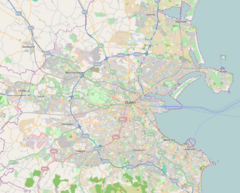In 1836, a committee of Commissioners was appointed by the British Government to identify a system of rail routes throughout Ireland which would best serve the interests of the country as a whole.[6] In their report of 1838, Kingsbridge, or 'King's Bridge', was selected as the optimum location for a terminus in Dublin which would most conveniently serve a main trunk railway line to the southern and western districts of Ireland.[6] The site had been known as Kingsbridge since the completion of the nearby King's Bridge over the River Liffey in 1828.[7]
The Great Southern and Western Railway (GS&WR) company was authorised by an Act passed in 1844 and began selecting a site in Dublin for their main city terminus, as well as the site of their headquarters.[6] In a series of pamphlets, the promoters of a proposed rail link to Cashel, County Tipperary argued that Kingsbridge was the better choice for a Dublin terminus over a competing proposal for a Portobello terminus, due to it being conveniently located next to the quays, Smithfield cattle market, hay and straw markets, wool and butter cranes, woollen, cotton, iron and leather warehouses, the Linenhall area, as well as sites of strategic military importance such as the Royal Barracks.[6]
An Incorporation Act entitled “An Act for Making and Maintaining a Railway from the City of Dublin to the Town of Cashel, with a Branch to the Town of Carlow" was passed and established in law.[6] On 28 October 1845 the Great Southern and Western Railway Company bought a site in Dublin adjoining the Military Road, and another parcel of ground, from the Right Honorable Henry John Lord Viscount Palmerston for £1,600.[lower-alpha 1] In December 1845 the GS&WR began advertising for tenders for building the Kingsbridge railway terminus on the land they had recently bought.[6]
The station opened on 4 August 1846 as the terminus and headquarters of the Great Southern and Western Railway with the Freeman's Journal describing how "carriages of all classes were densely crowded with passengers, thus giving early evidence of the vast traffic which is likely to accrue on the line when in full and perfect operation".[6] The first regular passenger train service from the station commenced later that month with the running of two trains each way daily between Dublin and Carlow (Carlow-bound trains departed Dublin at 9am and 5pm).[6] Trains were scheduled to take about 2hr 35min for the 56 mi (90 km) stretch to Carlow from where conventional mail coach connections could carry passengers onwards to Kilkenny, Clonmel, Waterford or Cork.
The passenger terminal and buildings were built to designs by London-born architect Sancton Wood, and the train sheds and infrastructure were designed by Irish-born railway engineer John MacNeill.[1] Regarding the architectural merits of the passenger terminal, historian Maurice Craig described it thus: "a delightful building, a renaissance palazzo, gay and full-blooded, with fruity swags and little domed towers on the wings, a thoroughgoing formal composition, excellently articulated".[9]
When first constructed the station had only two platforms separated by 5 carriage lines. Two of the lines were subsequently replaced by a two-sided platform and the remaining carriage line also removed. An additional platform, created in 1872 on the south side of the station, beyond the station roof, was known as the "military platform" - the intention being that military personnel could be kept separate from the rest of the public.[10] Due to the need to cater for increased demand and reduce delays, three new platforms were incorporated in August 2002 as part of a €170,000,000 development incorporating improved signalling and approach track-work.[11]
In 1966, on the 50th anniversary of the Easter Rising, it was renamed "Heuston Station" in honour of Seán Heuston, a young railway worker who commanded a nearby post in the 1916 Easter Rising. Heuston was one of the 16 executed by the British after that Rising, and had previously worked in the station's offices.[7]
Since the station's refurbishment and modernisation (by Quinn Savage Smyth architects and engineers Buro Happold)[12] its retail facilities now include a branch of Easons, as well as some dining facilities, including a branch of Supermacs, several cafés, a kiosk, and a large pub.[13]
A maintenance depot at the Inchicore railway works is located approximately three kilometres (two miles) away and, as with Heuston Station itself, was also opened in 1846.[14]
Based on 2019 National Transport Authority figures for "boardings and alightings", Heuston was then the third busiest station in Ireland, behind Connolly and Pearse stations, also in Dublin.[4] All services leave the station on a triple line as far as Inchicore, quadruple line until Hazelhatch, and thereafter only double line (one each way).[citation needed]
Rail services
The following services depart Heuston on weekdays:[15][needs update]
Heuston is the terminus for the mainline to Cork, and there are key service and transfer points in the Cork-bound direction at:
More information Preceding station, Iarnród Éireann ...
Close
Links to other main railway stations
Before 2016, the physical rail link between Connolly Station and Heuston via the Phoenix Park Tunnel was usually only used for freight and rolling stock movements. Once or twice a year special trains operated, usually from Cork to Connolly for Gaelic Athletic Association matches at Croke Park. A more regular service along this route began on 21 November 2016.[19]
The Luas light rail red line connects the two stations (apart from off-peak Saturdays, Sundays and bank holidays).[20]
Dublin Express has a direct service to Dublin Airport.[citation needed]
There are nine platforms: eight terminal platforms and one through platform. Platform 1 is an extension to Platform 2, and is reachable only via that platform. Prior to Heuston's 2002-2004 upgrade, there were five terminal platforms.[21][22]
The through platform is numbered Platform 10 and is situated on the Phoenix Park Tunnel line, which connects to Connolly Station.[22] There is no platform nine.[22] Platform 10 is some distance from the main concourse and is not used for any regularly scheduled trains.





